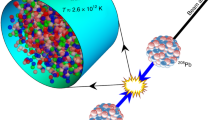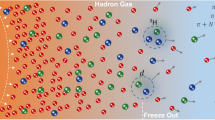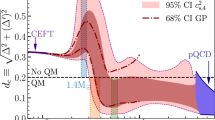Abstract
Quantum chromodynamics (QCD) is the theory of the strong interaction, explaining (for example) the binding of three almost massless quarks into a much heavier proton or neutron—and thus most of the mass of the visible Universe. The standard model of particle physics predicts a QCD-related transition that is relevant for the evolution of the early Universe. At low temperatures, the dominant degrees of freedom are colourless bound states of hadrons (such as protons and pions). However, QCD is asymptotically free, meaning that at high energies or temperatures the interaction gets weaker and weaker1,2, causing hadrons to break up. This behaviour underlies the predicted cosmological transition between the low-temperature hadronic phase and a high-temperature quark–gluon plasma phase (for simplicity, we use the word ‘phase’ to characterize regions with different dominant degrees of freedom). Despite enormous theoretical effort, the nature of this finite-temperature QCD transition (that is, first-order, second-order or analytic crossover) remains ambiguous. Here we determine the nature of the QCD transition using computationally demanding lattice calculations for physical quark masses. Susceptibilities are extrapolated to vanishing lattice spacing for three physical volumes, the smallest and largest of which differ by a factor of five. This ensures that a true transition should result in a dramatic increase of the susceptibilities. No such behaviour is observed: our finite-size scaling analysis shows that the finite-temperature QCD transition in the hot early Universe was not a real phase transition, but an analytic crossover (involving a rapid change, as opposed to a jump, as the temperature varied). As such, it will be difficult to find experimental evidence of this transition from astronomical observations.
This is a preview of subscription content, access via your institution
Access options
Subscribe to this journal
Receive 51 print issues and online access
$199.00 per year
only $3.90 per issue
Buy this article
- Purchase on Springer Link
- Instant access to full article PDF
Prices may be subject to local taxes which are calculated during checkout




Similar content being viewed by others
References
Gross, D. J. & Wilczek, F. Ultraviolet behavior of non-abelian gauge theories. Phys. Rev. Lett. 30, 1343–1346 (1973)
Politzer, H. D. Reliable perturbative results for strong interactions? Phys. Rev. Lett. 30, 1346–1349 (1973)
Karsch, F., Neuhaus, T., Patkos, A. & Rank, J. Critical Higgs mass and temperature dependence of gauge boson masses in the SU(2) gauge-Higgs model. Nucl. Phys. Proc. (Suppl.) 53, 623–625 (1997)
Kajantie, K., Laine, M., Rummukainen, K. & Shaposhnikov, M. E. Is there a hot electroweak phase transition at m h > m w? Phys. Rev. Lett. 77, 2887–2890 (1996)
Csikor, F., Fodor, Z. & Heitger, J. Endpoint of the hot electroweak phase transition. Phys. Rev. Lett. 82, 21–24 (1999)
Gurtler, M., Ilgenfritz, E.-M. & Schiller, A. Where the electroweak phase transition ends. Phys. Rev. D 56, 3888–3895 (1997)
Schwarz, D. J. The first second of the universe. Ann. Phys. 12, 220–270 (2003)
Witten, E. Cosmic separation of phases. Phys. Rev. D 30, 272–285 (1984)
Applegate, J. H. & Hogan, C. J. Relics of cosmic quark condensation. Phys. Rev. D 31, 3037–3045 (1985)
Pisarski, R. D. & Wilczek, F. Remarks on the chiral phase transition in chromodynamics. Phys. Rev. D 29, 338–341 (1984)
Celik, T., Engels, J. & Satz, H. The order of the deconfinement transition in SU(3) Yang–Mills theory. Phys. Lett. B 125, 411–414 (1983)
Kogut, J. B. et al. Deconfinement and chiral symmetry restoration at finite temperatures in SU(2) and SU(3) gauge theories. Phys. Rev. Lett. 50, 393–396 (1983)
Gottlieb, S. A. et al. The deconfining phase transition and the continuum limit of lattice quantum chromodynamics. Phys. Rev. Lett. 55, 1958–1961 (1985)
Brown, F. R., Christ, N. H., Deng, Y. F., Gao, M. S. & Woch, T. J. Nature of the deconfining phase transition in SU(3) lattice gauge theory. Phys. Rev. Lett. 61, 2058–2061 (1988)
Fukugita, M., Okawa, M. & Ukawa, A. Order of the deconfining phase transition in SU(3) lattice gauge theory. Phys. Rev. Lett. 63, 1768–1771 (1989)
Halasz, M. A., Jackson, A. D., Shrock, R. E., Stephanov, M. A. & Verbaarschot, J. J. M. On the phase diagram of QCD. Phys. Rev. D 58, 096007 (1998)
Berges, J. & Rajagopal, K. Color superconductivity and chiral symmetry restoration at nonzero baryon density and temperature. Nucl. Phys. B 538, 215–232 (1999)
Schaefer, B.-J. & Wambach, J. The phase diagram of the quark meson model. Nucl. Phys. A 757, 479–492 (2005)
Herpay, T., Patkos, A., Szep, Zs. & Szepfalusy, P. Mapping the boundary of the first order finite temperature restoration of chiral symmetry in the mπ–mK plane with a linear σ model. Phys. Rev. D 71, 125017 (2005)
Brown, F. R. et al. On the existence of a phase transition for QCD with three light quarks. Phys. Rev. Lett. 65, 2491–2494 (1990)
Khan, A. A. et al. Phase structure and critical temperature of two flavor QCD with renormalization group improved gauge action and clover improved Wilson quark action. Phys. Rev. D 63, 034502 (2001)
Karsch, F. et al. Where is the chiral critical point in three-flavor QCD? Nucl. Phys. Proc. Suppl. 129, 614–616 (2004)
Davies, C. T. H. Lattice QCD. In Heavy Flavor Physics, Scottish Graduate Textbook Series (eds Davies, C. T. H. & Playfer, S. M.) 7–23 (Institute of Physics, 2002)
Ukawa, A. Lectures on lattice qcd at finite temperature. In Proceedings of the 1993 Uehling Summer School ‘Phenomenology and Lattice QCD (Seattle, July 1993)’ (eds Kilcup, G. & Sharp, S.) (World Scientific, Singapore, 1995)
Aoki, Y., Fodor, Z., Katz, S. D. & Szabo, K. K. The equation of state in lattice QCD: with physical quark masses towards the continuum limit. J. High-Energy Phys. 01:089 (2006)
Bernard, C., Golterman, M. & Shamir, Y. Observations on staggered fermions at non-zero lattice spacing. Phys. Rev. D 73, 114511 (2006)
Gottlieb, S. A. et al. Hybrid molecular dynamics algorithms for the numerical simulation of quantum chromodynamics. Phys. Rev. D 35, 2531–2542 (1987)
Clark, M. A. & Kennedy, A. D. The rhmc algorithm for two flavors of dynamical staggered fermions. Nucl. Phys. Proc. Suppl. 129, 850–852 (2004)
Fodor, Z., Katz, S. D. & Papp, G. Better than $1/mflops sustained: A scalable PC-based parallel computer for lattice qcd. Comput. Phys. Commun. 152, 121–134 (2003)
Acknowledgements
We thank F. Csikor, A. Dougall, K.-H. Kampert, M. Nagy, Z. Rácz and D. J. Schwarz for discussions. This research was partially supported by a DFG German Science grant, OTKA Hungarian Science grants and an EU research grant. The computations were carried out on PC clusters at the University of Budapest and Wuppertal with next-neighbour communication architecture29 and on the BlueGene/L machine in Jülich. A modified version of the publicly available MILC code (http://physics.indiana.edu/~sg/milc.html) was used.
Author information
Authors and Affiliations
Corresponding author
Ethics declarations
Competing interests
Reprints and permissions information is available at www.nature.com/reprints. The authors declare no competing financial interests.
Rights and permissions
About this article
Cite this article
Aoki, Y., Endrődi, G., Fodor, Z. et al. The order of the quantum chromodynamics transition predicted by the standard model of particle physics. Nature 443, 675–678 (2006). https://doi.org/10.1038/nature05120
Received:
Accepted:
Issue Date:
DOI: https://doi.org/10.1038/nature05120
This article is cited by
-
Cosmological phase transitions in composite Higgs models
Journal of High Energy Physics (2023)
-
Hadronic effects on the abundance of strange resonances in heavy ion collisions
Journal of the Korean Physical Society (2023)
-
Pion screening mass at finite chemical potential
Journal of High Energy Physics (2023)
-
Monopoles and confinement in three dimensions from holography
Journal of High Energy Physics (2023)
-
QCD-collapsed domain walls: QCD phase transition and gravitational wave spectroscopy
Journal of High Energy Physics (2023)
Comments
By submitting a comment you agree to abide by our Terms and Community Guidelines. If you find something abusive or that does not comply with our terms or guidelines please flag it as inappropriate.



